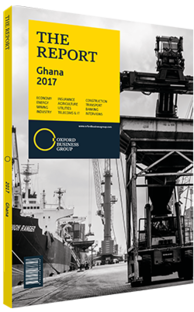Ghana's currency may stabilise following a volatile period
While currencies across Africa slid against the dollar over 2015, the cedi was among the worst performing, falling by 19.6%. After a volatile summer, Ghana’s currency began to stabilise in the third quarter of 2015, ending the year at GHS3.82:$1. This held through the first half of 2016, with the cedi trading in the range of 3.78-4.06 to the dollar.
Mounting public debt, rising inflation and increased levels of non-performing loans in the banking sector were among the factors contributing to heightened risk in the economy. This led the cedi to an all-time low of GHS4.42:$1 in June 2015, representing a 38% deprecation since January of that year. The signing of the IMF extended credit facility in April 2015 did little to stem the tide.
Support
Two announcements by the Bank of Ghana (BoG) are credited with the currency’s rally in July 2015. First, the central bank increased the sale of dollars on the interbank market from $14m a week to up to $20m a day. This propped up demand for the cedi. While this was seen as a departure from the BoG’s usual disengagement from currency markets, the bank assured investors that this short-term measure did not cause it to exceed its average market activity for the year.
Second, the BoG announced that it was opening the purchase of the cedi-denominated, two-year government note to foreign investors. This had the potential to raise demand for cedi as investors converted dollars and other currencies into cedis for the purpose of investing in government debt. The bounce in the cedi proved short-lived, however, as weakness returned in August 2015.
Summer Streak
Summer is traditionally a volatile period for the cedi. Richard Amegashiti, head of brokerage services at Liberty Capital Holdings, told OBG, “We have seen that after international companies declare their profits, usually between March and June, they repatriate these funds to their home countries, weakening the local currency.” Historical data supports this assertion, with the cedi seeing major depreciation in the summers of 2014 and 2015. This pattern was also seen in the summer of 2012, but to a lesser extent.
By early December 2016 the cedi had slipped to 4.21 to the dollar, although this was largely down to the latter’s strengthening over recent months, and this was a pattern that was reflected across most developing economies.
Concrete steps by the government and the IMF towards fiscal and monetary stability led to a reduction of risk expectations for the economy, which translated into a more stable currency. While the cedi remains well above historical trading levels, the reduction in volatility makes planning for the economy’s future easier.
Looking forward, the cedi is expected to remain roughly in line with trading during the first half of 2016. “If you want to keep the cedi constant at a particular rate, it can be done, but there are costs,” Johnson Asiama, second deputy governor for the BoG, told OBG. “You lose reserves, which has an even more potent negative effect. Our reserves are at comfortable levels, and the cedi has held its own since the end of 2015. Historically, the second half of the year is always very good for the cedi. That is when the flows and stability come in.”
Oil Exports
As fiscal consolidation and the restoration of macrostability move forward, there are fewer risks being factored into the exchange rate. In addition, once new oilfields – which are expected to come on-line by early 2017 – begin producing and exporting oil, Ghana could see materially more dollars flowing into the country, supporting demand for the cedi.
Assuming a smooth transition of power following the December presidential election, the cedi is expected to remain steady going into 2017.
You have reached the limit of premium articles you can view for free.
Choose from the options below to purchase print or digital editions of our Reports. You can also purchase a website subscription giving you unlimited access to all of our Reports online for 12 months.
If you have already purchased this Report or have a website subscription, please login to continue.

